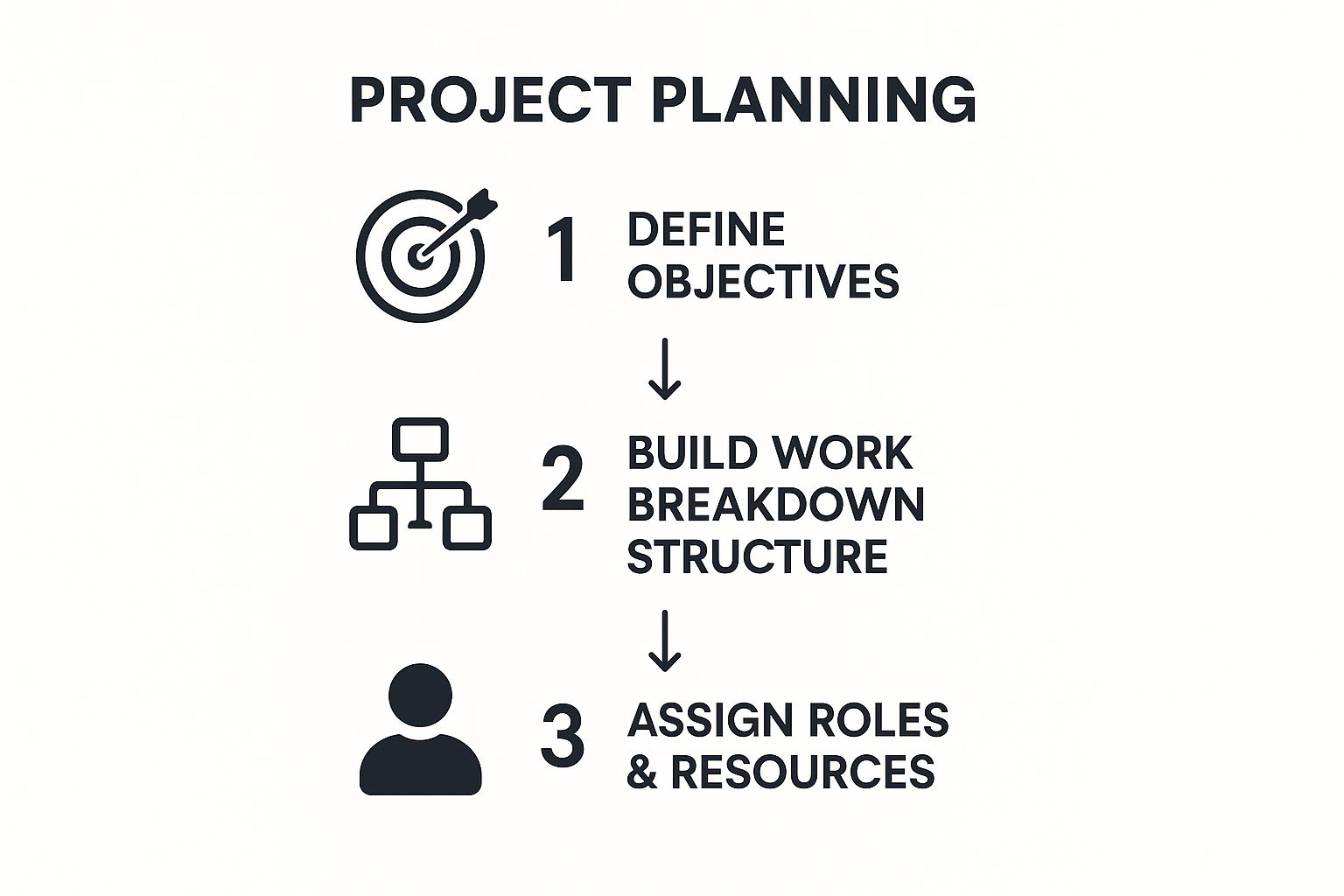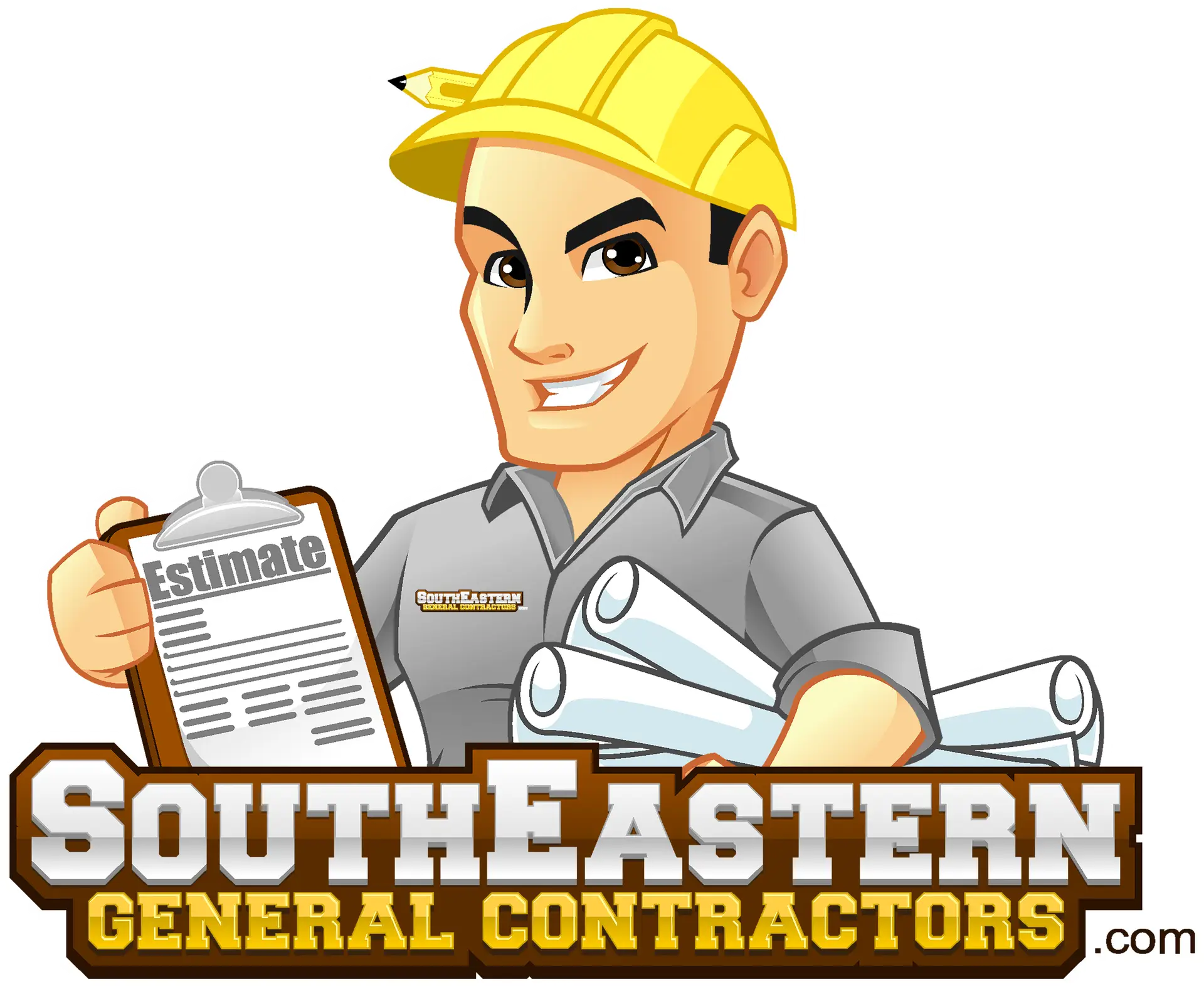
Master Project Management Fundamentals for Success
Ever wonder what turns a brilliant idea into a finished building? That's the magic of project management fundamentals. Think of it like building a custom home—you wouldn't just grab a hammer and start whacking away without a solid blueprint, a firm budget, and a realistic schedule. These fundamentals are that essential framework, giving you the control to steer any project toward a successful finish. For us at Southeastern General Contractors (SEGC), this isn't just theory; it's the disciplined approach that has fueled over 21+ years of proven results across North Carolina.
So, What Are Project Management Fundamentals, Really?
At its heart, project management is the art and science of wrestling an idea into reality. It’s the structured, methodical way you lead a team to hit all their goals while juggling the classic constraints: time, money, and scope. For SEGC, these aren't just buzzwords. They're the real-world practices that have let us build legacies across the Fayetteville and Lumberton communities for over two decades.
Let's say you're building a new community center. The project management fundamentals are the make-or-break questions you have to nail down before the first shovel ever touches dirt:
- What are we actually building? (Scope)
- When does it need to be finished? (Schedule)
- How much is this going to cost? (Budget)
- Who is doing what? (Resources)
- How do we make sure it’s built right? (Quality)
Answering these questions gives everyone a clear roadmap. Without it, projects easily spiral into missed deadlines, blown budgets, and disappointing results. It's the difference between a controlled, predictable process and a chaotic, stressful mess—a difference we pride ourselves on delivering.
The Bedrock of Trust and Predictability
Great project management is built on a foundation of client trust. When a business in Fayetteville or a public entity in Lumberton decides to work with us, they're handing over their vision and their investment. Our unwavering commitment to these core principles is how we honor that trust, keeping things transparent and predictable from start to finish.
This disciplined approach is what allows us, as a Native American-owned, 8(a), and HUBZone-certified firm, to manage complex government contracts and highly detailed custom homes with the exact same level of precision and quality. It all comes down to creating a system where everyone—from our clients to our crew on the ground—knows the plan, their part in it, and what success looks like.
“A project without a critical path is like a ship without a rudder. At SEGC, the fundamentals are our rudder. They guide every decision, ensuring we navigate challenges effectively and deliver on our promises, building the client trust that has defined our work for 21+ years.”
It’s More Than Just a Checklist
It’s tempting to see project management as a dry series of tasks on a Gantt chart. But it’s so much more than that—it's a deeply human process. It’s about clear communication, motivating leadership, and a team that tackles problems together. At the end of the day, it's about rallying people around a shared goal to build something lasting.

Here’s a real-world example: on a recent commercial build in Lumberton, surprise supply chain snags put our timeline at risk. Instead of hitting the panic button, our project manager leaned on fundamental risk management. He immediately got the client, suppliers, and our team in a room, figured out how to re-sequence the work, and leveraged our local leadership to source alternative materials without sacrificing quality or breaking the bank.
That's what project management fundamentals look like in the wild. It isn't a rigid set of rules; it's a flexible framework that empowers a team to adapt and win. By mastering these basics, you turn ambitious goals into real, high-quality results. Our track record, backed by our esteemed 8(a) certification and 21+ years of proven results, is living proof of the power of getting the fundamentals right, every single time.
The 5 Phases of a Successful Project
Every project has a life of its own, a natural journey from a glimmer of an idea to a finished reality. Think of it less like a rigid process and more like building a custom home in the Fayetteville area. From that first "what if?" conversation to the day you hand over the keys, there's a predictable rhythm. This rhythm is broken down into five distinct phases.
Let's stick with that custom home analogy. It makes these concepts feel a lot more real than some dry textbook definition.
- Phase 1: Initiating. This is the dream. It’s you and the client standing on an empty plot of land, imagining the finished house. You define the big picture, get the official green light, and establish the project's feasibility. It's all about getting started on the right foot with a clear purpose.
- Phase 2: Planning. Now we're at the drafting table, creating the actual blueprints. This is, without a doubt, the most critical part of the entire project. We map out every single detail—from budgets and timelines to materials and risk mitigation.
- Phase 3: Executing. Time to break ground! The crew is on-site, framing walls, running wires, and physically bringing those blueprints to life. This is the "doing" phase where the tangible work happens and our commitment to quality shines.
- Phase 4: Monitoring & Controlling. While the hammers are swinging, someone's got to be watching the big picture. Are we on schedule? Is the budget holding steady? This phase runs side-by-side with execution, ensuring the work constantly aligns with the plan we promised the client.
- Phase 5: Closing. The final walkthrough. The punch list is complete, and you officially hand over the keys. The project is formally wrapped up, all documentation is signed, and the client's vision is now their reality—a new legacy.
Having been a locally-led 8(a) and HUBZone certified contractor for years, we've seen it all. And I can tell you this with 100% certainty: projects succeed or fail in the planning phase. A rock-solid plan isn't just paperwork; it's the single best tool you have to prevent headaches, avoid costly mistakes, and deliver exactly what the client trusted you to build.
To give you a clearer picture of how these phases flow, here’s a breakdown of what happens in each one.
The 5 Phases of the Project Management Lifecycle
This table shows you the main goal for each phase and gives a concrete example of the kind of actionable insights we bring at SEGC during that time.
| Phase | Primary Objective | Key Activities Example (SEGC's Actionable Approach) |
|---|---|---|
| 1. Initiating | Define the project's purpose and get formal approval to begin. | Develop a project charter, conduct a feasibility study, and identify all key stakeholders for transparent communication. |
| 2. Planning | Create a detailed, comprehensive roadmap for the entire project. | Define project scope, create a Work Breakdown Structure (WBS), and develop a transparent budget and realistic schedule. |
| 3. Executing | Perform the actual work defined in the project plan. | Procure high-quality materials, manage the construction team with clear direction, and hold regular progress meetings to ensure alignment. |
| 4. Monitoring & Controlling | Track progress, manage changes, and ensure the project stays on track. | Perform rigorous quality control checks, track key performance indicators (KPIs), and proactively manage risks to protect client investment. |
| 5. Closing | Formally complete the project and hand off the final deliverables. | Conduct a final inspection, complete all project documentation, and get client sign-off, ensuring their legacy is perfectly realized. |
As you can see, each phase has a clear purpose that builds on the last, creating a logical path from start to finish.
Breaking Down the All-Important Planning Process
Let's zoom in on that planning phase. This is where project management fundamentals truly come into play. It's so much more than just throwing dates on a calendar. It's about building a bulletproof strategy that anticipates challenges before they happen.
Getting this right is a massive deal. In fact, industry research shows that a staggering 10% of every dollar spent on projects is wasted simply due to poor performance. That's a direct consequence of flimsy planning. When you consider that over 85% of project managers are juggling multiple projects at once, there's absolutely no room for inefficiency. A tight plan is non-negotiable.
This is our playbook. The visual below shows how we move from a clear objective to a fully structured and resourced project plan before a single shovel hits the dirt.

It all starts with defining what "success" looks like. Once that's crystal clear, every other decision about structure, resources, and timing just falls into place.
At SEGC, we believe building a legacy starts with building client trust. A transparent, meticulously detailed plan isn't just a document; it's our promise to a client that we will be responsible stewards of their vision and investment.
This isn't just a slogan for us; it’s baked into how we operate in communities like Fayetteville and Lumberton. For a deeper dive into our on-the-ground methods, you can explore how we manage construction projects from start to finish.
From Blueprint to Reality
With the plan locked and loaded, the execution and monitoring phases kick off, and these two are joined at the hip. While our team is physically building (executing), our project managers are constantly watching (monitoring). They're tracking metrics, keeping an eye on progress, and managing any curveballs that come our way.
Let’s say we're on a commercial build and a key material is delayed. A rookie mistake would be to let it stall the entire project. But because our monitoring process flags it instantly, we can be proactive. We get the client in the loop, use our deep local supplier network to find a quick alternative, and reshuffle the work sequence so other crews stay busy.
What could have been a major roadblock becomes a minor blip.
This constant feedback loop of doing and checking is what keeps a project healthy and moving forward. It’s how we ensure the final building delivered in the closing phase is a perfect match for the vision we all shared back on that empty plot of land. It’s how we’ve spent over 21 years turning our clients' dreams into tangible legacies.
Your Toolkit of Core Knowledge Areas
If the five project phases are your roadmap for the journey, then these ten core knowledge areas are the tools in your truck. You can't fix a problem on the road without the right wrench, and you can't steer a project to success without mastering these domains. They’re the levers you pull and the dials you tune to keep everything, from the budget to team morale, humming along smoothly.
At SEGC, we don't just talk about these concepts—we live them on job sites every single day in Fayetteville and across North Carolina. Getting these project management fundamentals right isn't academic; it's how we confidently deliver on the promises that build client trust.

Let's pop the hood and look at the most critical tools in this kit.
Taming the Triple Constraint
At the very core of every project, you’ll find three elements tangled together in a delicate dance. This is the famous "triple constraint." Poke one, and the other two will almost certainly flinch.
- Scope Management: This is all about drawing a firm line in the sand. You define exactly what work needs to be done—and just as importantly, what doesn’t. A rock-solid scope is your best defense against "scope creep," that sneaky villain who adds "just one more thing" until your timeline and budget are toast.
- Schedule Management: This is more than just circling a date on the calendar. It’s the art of choreographing the project's flow, sequencing every task logically so you move from one milestone to the next without tripping over your own feet.
- Cost Management: Here’s where you plan, estimate, and guard the project's funds. The mission is simple: finish the job without breaking the bank. For us, this is where client trust is forged in steel.
Think of it like a three-legged stool. If you shorten one leg, the whole thing wobbles and tips over. That's why you have to manage them as a single, unified system.
The Pillars of Quality and Resources
Beyond that core trio, a few other areas act as the support pillars holding up the entire project. Neglect them, and the whole structure could come crashing down.
Quality Management
Let's get one thing straight: quality isn't about gold-plating everything. It's about delivering precisely what was agreed upon and meeting all the required standards. It’s the ongoing process of making sure the final product is fit for its purpose. For a custom home, that means using the right materials, acing every code inspection, and delivering the beautiful craftsmanship the client dreamed of.
For instance, on a recent federal project near Fort Bragg, our HUBZone and 8(a) certifications held us to an incredibly high bar for quality. Our quality management was relentless—daily site walks, strict material checks, and constant communication to ensure every last spec was hit perfectly. This hands-on approach catches problems early, prevents expensive rework, and builds serious confidence with our clients.
At SEGC, quality is non-negotiable. It’s woven into our DNA because we aren’t just building structures; we’re building a legacy of trust with our clients and in our local communities like Lumberton and Fayetteville.
Resource Management
This covers all the "who" and "what" of your project. It’s about getting the right people on board, helping them grow, and leading them effectively. But it's also about managing the physical stuff—the machinery, the materials, the equipment.
A great project manager knows their most valuable resource isn’t a crane; it’s their crew. As a local leader, we believe fostering a collaborative, motivated team is just as crucial as ordering the right grade of concrete.
Preparing for the Unexpected
Finally, two of the most vital project management fundamentals are about looking down the road and preparing for what’s coming—both the curveballs and the home runs.
- Risk Management: This is the art of asking "what if?" and having an answer ready. You identify potential storm clouds on the horizon, figure out how bad they could be, and have an umbrella ready long before it starts to rain. A risk isn't a problem yet, but with proactive management, you can ensure most of them never become one.
- Stakeholder Management: A stakeholder is anyone with a pulse and an interest in your project—from the client and your team to the local community and government officials. Keeping them in the loop and managing their expectations is the secret sauce for a smooth, drama-free project.
These areas all work together, creating a powerful system for keeping a project under control. To see how we put these principles to work on the ground, check out our deep dive into what is construction management. This isn’t about ticking boxes. It’s about skillfully using this toolkit to navigate the real-world challenges of every unique project, reinforcing the trust we've earned over 21+ years of proven results.
Alright, let's get down to the brass tacks. You've got a plan, you know your destination—now you need to pick the right ride to get you there. Choosing your project management methods and software is a lot like that. You wouldn't show up to a mountain expedition in a Lamborghini, right? Same idea.
Here at SEGC, a proud Native American-owned firm, we’ve built our reputation on 21+ years of proven results by doing one thing really well: picking the right tool for the job. It's not about chasing the latest tech trend. It’s about blending smart, modern tools with old-school values like honest communication and a commitment to quality. That’s how we deliver on our promises and build client trust.
Waterfall vs. Agile: The Skyscraper and the Community Garden
You'll hear two words thrown around a lot: Waterfall and Agile. Let's cut through the jargon. It’s actually pretty simple.
-
Waterfall: Imagine building a skyscraper. You have to lay the foundation before you can frame the first floor. You finish one floor completely before moving up to the next. The blueprints are locked in from day one, and everything flows downwards in a neat, predictable sequence—like a waterfall. This is perfect for projects where the end goal is crystal clear from the start, like most of the construction work we handle around Fayetteville.
-
Agile: Now, picture you're starting a community garden. You might start by planting one small patch of tomatoes. You see how they grow, get some feedback from your neighbors ("More basil!"), and then you adjust your plan for the next plot. This approach is all about working in short, focused bursts (they call them "sprints") and adapting as you go. It's ideal for projects where things are expected to change, like developing a new software application.
So which one is better? Neither. The best one is the one that fits your project. For building a custom home, the rock-solid predictability of the Waterfall method gives our clients peace of mind. But if we're tweaking an internal process, we might borrow from Agile to test ideas and make quick improvements.
Finding the Right Project Management Software
The right software can be a total game-changer. It takes you from a chaotic mess of spreadsheets and buried emails to a single, clear dashboard where everyone can see what’s happening. This is a non-negotiable part of modern project management fundamentals.
And we’re not the only ones who think so. The global market for this kind of software is set to hit $12.02 billion by 2030. Why? Because it works. A whopping 82% of companies are using these tools to get more done, a shift we're seeing everywhere from the job site to the tech campus. Funnily enough, it's often the smaller businesses that are quickest on the uptake. You can dig into more of these project management trends to see just how much technology is moving the needle.
At SEGC, technology serves a single purpose: to build client trust. We use tools like Otter.ai and Loom to give our clients a real-time window into their project. They see visual updates and have a clear record of every conversation, ensuring total transparency from the first handshake to the final walkthrough.
Making the Call: What's Right for You?
So, how do you make the right choice for your own project? It boils down to asking a few honest questions:
- How locked-in are my project requirements? If they're set in stone, Waterfall is your friend. If you expect them to evolve, lean towards Agile.
- How often will the client need to weigh in? Agile is built for constant collaboration and feedback loops. Waterfall has more formal, phase-gate reviews.
- What can my team realistically handle? Don't pick a system so complex that the learning curve tanks your schedule. Choose tools your team can actually use effectively from the get-go.
Ultimately, you want tools and methods that make your life easier, not harder. At SEGC, our deep experience—whether on a complex government contract requiring our 8(a) expertise or a beautiful custom home in Lumberton—is what helps us guide our clients to the right answer. We’re here to help you choose wisely, setting you up for success right from the start.
The Human Side of Project Management
Let's be honest. You can have the most beautiful Gantt charts, the most detailed spreadsheets, and the slickest software on the market, but at the end of the day, projects are about people. The real magic isn't in a textbook; it's in human connection. We're talking about the soft skills—communication, leadership, stakeholder engagement—that deliver seriously hard results.

Here at SEGC, we’ve learned a thing or two over our 21+ years in the business. The biggest lesson? Building client trust is infinitely more important than just building structures. It’s the not-so-secret secret to our success and the foundation of every single thing we do, whether it's a major federal contract or a custom home in Fayetteville. It's how we build legacies, not just buildings.
Communication Is More Than Just Talk
Think of communication as the project's central nervous system. When it’s working well, information flows freely, and everything is coordinated. It’s not about blasting out emails; it’s about creating a genuine, shared understanding. Everyone, from the client signing the checks to the crew on the ground, needs to feel heard, respected, and aligned with the same goal.
It’s no surprise that poor communication is the top project killer. On the flip side, great communication creates a space where people feel safe enough to raise a red flag before a small issue snowballs into a costly disaster. It’s the difference between constantly putting out fires and calmly steering the ship.
A Masterclass in Listening from Lumberton
We had a commercial project in Lumberton a while back that drove this point home perfectly. We were juggling multiple community groups, and each one had a different vision and a different set of worries. Things were grinding to a halt because of all the friction. Instead of doubling down and pushing our own plan, our project manager did something deceptively simple: he stopped talking and started listening.
Seriously. We set up open forums, not to lecture people, but to actually hear them out. Our team had one-on-one chats, took pages of notes, and made sure every single concern was acknowledged. That one simple act of listening changed everything. It built a bridge of trust where a wall of opposition had been forming.
“On that Lumberton project, we proved that listening is our most powerful tool. By prioritizing stakeholder needs and fostering open dialogue, we turned potential roadblocks into pathways for collaboration. That’s the SEGC way—it’s how our Native American-owned values and local leadership translate into real-world results.”
This wasn't just about being nice, either. It was just plain smart. By truly getting what everyone needed, we could tweak our plan to keep everyone happy and, most importantly, get the project across the finish line.
Leading with a Foundation of Trust
Ultimately, the human side of project management fundamentals boils down to leadership. A true leader doesn't just manage a to-do list; they inspire a team. They cultivate a culture where everyone feels accountable and respected.
This philosophy is baked into our DNA as an 8(a) and HUBZone-certified firm. We know our reputation in communities like Fayetteville and Lumberton is our most valuable asset. That’s why we lead every project with a rock-solid commitment to integrity and quality. We treat your investment like it’s our own, ensuring the relationships we build are just as sturdy and long-lasting as the structures we create.
From Project to Legacy: Building Something That Lasts
We’ve walked through the nuts and bolts of project management—the five phases, the must-have tools, and the people who make it all happen. These project management fundamentals are the secret sauce for turning a great idea into a tangible reality, whether you're breaking ground on a new community center in Lumberton or spearheading a major company-wide initiative.
But let’s be honest. The real win isn’t just ticking off the final task. It’s about creating something with staying power, something that makes a real impact long after the dust settles.
That’s the philosophy we live and breathe here at SEGC. For over 21+ years, we haven't just been constructing buildings in Fayetteville and the surrounding areas; we’ve been helping build legacies. It’s this deep-seated commitment to client trust and quality that elevates a project from just a structure to a landmark people will be proud of for decades.
How to Make Your Work Matter
So, how do you make sure your work isn't just a flash in the pan? It’s all about putting these core principles into action, day in and day out.
- Plan Like You Mean It: Think of your project plan as more than a to-do list. It's your roadmap, your promise. A detailed, well-thought-out plan shows you respect the client's dream, their investment, and builds a foundation of trust.
- Lead From the Front: Great leadership isn't about barking orders. It's about building trust. When you create a culture of open communication and respect, your team feels empowered to jump on challenges before they become full-blown problems.
- Deliver on Your Word: Your reputation is built on a thousand small decisions. From the materials you choose to how you keep stakeholders in the loop, every choice should scream quality and integrity.
The world needs more people who can master these skills. In fact, the project management field is exploding, with a projected need for 2.3 million new professionals every single year just to keep up with global demand. That’s a massive number, and you can read more about the project management market growth to see just how critical these skills have become.
At SEGC, we see every handshake and every blueprint as a chance to build more than a building. As a Native American-owned business, we’re building relationships and strengthening our community. Our legacy isn't just in the structures we leave behind, but in the trust we earn along the way.
Ready to build something that truly matters? The first step is choosing a partner who gets it—a team that understands how different construction project delivery methods can shape your project's entire journey. Find a firm that doesn’t just see a project, but sees your vision for a lasting legacy.
Got Questions? We've Got Answers
Look, we get it. Stepping into the world of project management can feel like learning a new language. After helping folks in Fayetteville, Lumberton, and all over North Carolina for more than 21+ years, we've heard just about every question in the book. Let's clear up some of the most common ones.
What’s the Real Most Important Phase in Project Management?
If you ask ten different project managers, you might get ten different answers, but most of us old hands will point to one thing: Planning. Every other phase is vital, don't get me wrong, but the planning phase is where the magic really happens.
Think of it like building a house. You wouldn't just start throwing up walls without a solid blueprint, right? That's what planning is. It's where you map out every detail—the scope, the budget, the schedule, and all the things that could go sideways. A little extra sweat here saves a mountain of headaches (and money) down the road. It’s how we at SEGC build a rock-solid foundation of client trust before a single nail is hammered.
How on Earth Do I Pick the Right Project Management Method?
This is a big one, and the honest answer is: it depends entirely on what you're trying to do. There’s no magic bullet or one-size-fits-all solution.
- If your project is straightforward with a clear finish line, like building a new office, the classic Waterfall method is your friend. It's a simple, step-by-step process that keeps things orderly.
- But what if you're in a more creative or unpredictable space, like developing an app? That's where Agile shines. It's built for change, letting you adapt and get feedback as you go.
The trick is to think about your project's moving parts. How complex is it? How often will stakeholders want to chime in? Our experience as a Native American-owned and 8(a)-certified firm has shown us time and again that you have to fit the method to the mission, not the other way around.
Can I Really Use This Stuff for My Own Small Projects?
You bet! In fact, you absolutely should. These core ideas aren't just for massive construction jobs; they're for life. Planning a wedding? Renovating your kitchen? Even just organizing a big family reunion? The principles are exactly the same.
You're setting a goal (Initiating), figuring out your budget and timeline (Planning), getting the work done (Executing), checking in on your progress (Monitoring), and finally, popping the champagne (Closing). It brings order to the chaos, cuts down on stress, and you’ll be amazed at the results.
Ready to build something that truly stands the test of time? At South Eastern General Contractors, we don’t just put up buildings—we build lasting legacies on a foundation of client trust, quality, and over two decades of getting it done right. Let's build yours together.



